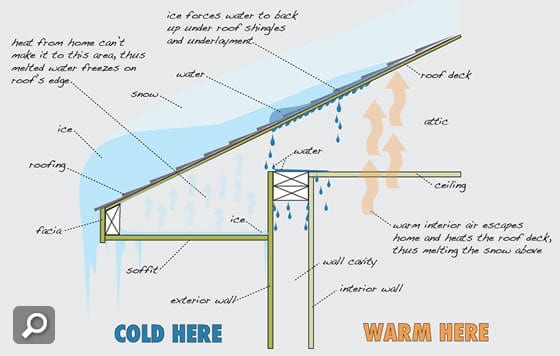What is an ice dam?
Short answer: An ice dam is the ridge of ice that forms at the edge of a roof which prevents melting snow from draining as it should. The water that backs up behind the ice dam can leak into the home and cause damage to walls, floors, ceilings, insulation, and other areas. See a basic illustration of an ice dam below. Large ice dam. Small ice dam.
Where do ice dams happen: Most ice dams occur on the lowest edge of your roof as described above. We frequently find them in other locations, however. Click here to see a drawing of common ice dam locations. Study this diagram closely as it is frequently the case that ice dams can not be identified from the ground.
What causes ice dams?
Short answer: Roof ice and ice dams result from the escape of heat into the attic or roof space. This heat builds up and eventually melts snow on the roof, which, as described above runs to the cold edge of the roof and forms an ice dam. Factors such as ventilation, insulation, solar orientation, tree coverage, home architecture, snow cover and weather conditions all interact to determine ice dam activity on every home. Because no two houses are the same, it is common to have neighboring homes on two ends of the ice dam spectrum; one may have major leaking, while the other is virtually unaffected.
Watch this short video on What is an Ice Dam and Ice Dam Prevention.
Tips on preventing damage: Preventing damage from an ice dam is pretty straight forward. It’s all about being proactive. When you think you may have a problem, it’s time to call The Ice Dam Company. Don’t wait until ice dams are on the news or in the Star Tribune. If you do, you will have to wait in line to get your ice dam removed, which can sometimes be a matter of days or weeks. It’s better to bite the bullet and address things before you have a real problem on your hands. Here are some common forms of damage done by ice dams. Ouch.
Learn more on ice dam prevention.
Ice Dams: Fact vs. Fiction
There is a lot of misinformation out there on the topic of ice dams. Our goal here is to be the single definitive source for all things relating to ice dams. Towards that end, here are some common misconceptions about ice dams, roof snow, roof ice and gutter ice removal.
Fact: Ice dams can occur with virtually no snow on your roof. It’s a question of ice accumulations. It takes very little actual moisture to form ice dams. Even a dusting of snow can create a problem. Of course it is most often the case the thick snow accumulations create ice dams more quickly.
Fiction: Gutters have something to do with ice dams. The truth is gutters have nothing whatsoever to do with ice dams. If your home is prone to ice dams you will get them either way. If you have gutters they will fill with ice and provide a foundation for the ice dam above. If you don’t have gutters, the ice dam simply builds on the cold edge of the roof. We provide ice dam removal for many homes each year that do not have gutters.
Fact: Gutter systems can be damaged by gutter ice. We see it every year. A section of otherwise fine gutter is either on the ground or hanging pathetically off the edge of the roof, filled with ice. Fresh water ice weighs about 60 pounds per cubic foot and gutters are not designed to tolerate that sort of load. See photo of gutter ice damaged by an ice dam.It’s important to initiate gutter ice removal sooner, then later.
Fiction: When it comes to insulation, the more the better. Improperly insulated homes are just as bad as under insulated homes when it comes to ice dams. and roof ice We have fixed countless bad insulation jobs for this reason. Specifically, we frequently find insulation done in such a way as to inhibit proper ventilation. Moreover, if you don’t address air leakage into the attic or rafter spaces, all the insulation in the world won’t prevent ice dams.
Fact: You can see ice dams from the ground. Not always. It’s true that you can usually spot a monster very easily. You can see the two foot icicles and the little glacier on your gutter. The sneaky ones are usually above skylights or in roof pan areas far out of sight. Sometimes ice dams grow up valleys and on top of dormers making it almost impossible to identify from the ground.
Fiction: Salt socks are a smart way to address ice dams. People use pantyhose, old socks and store-bought cloth tubes filled with a variety of ice-melting compounds for removing ice dams. Corrosive substances like rock salt, sodium chloride, calcium chloride, magnesium chloride and more to melt channels through their ice dams. Some compounds are better than others, but all present risks you should keep in mind. Some of the aforementioned chemicals affect the integrity or color of your roof, some are corrosive to the aluminum when gutter ice is removed this way, some are corrosive to valley metal and other flashings, some damage plant life as the water drains below. You are rolling the dice when you go this route so be aware.
Fact: Ice should be removed by steam. Here is the skinny. We are roofers and have fixed hundreds of roofs that have been damaged by well-intentioned professionals with hammers, picks and hatchets in their pursuit of removing ice dams to help their clients. The damage we have found caused by the less-than-professional souls is almost funny if it wasn’t so serious. In our years we have seen jobs with picks and hammers where removing ice dams was done successfully. It get’s down to a question of risk management. We strongly advise against the hack-a-teer approach even if it is a little cheaper. Roof Ice and Gutter Ice should always be removed with rock salt or warm water.
Fiction: Ice dams need to be thick to cause a problem. Ice dams as thin as one inch can cause big problems. A good general rule is that the steeper your roof, the thicker the ice dam has to be to cause problems. On lower pitched roofs even a thin ice dam can hurt.
Fact: The leaking caused by ice dams may not show up right away. It would be nice if water stains or mold manifested immediately upon entering your home but it simply does not work that way. Often the water that ice dams push into homes travels around wall and ceiling cavities, trapped by vapor barriers and other materials until it finds the path of least resistance to escape. By the time you see water inside, it’s usually been there for a while.


